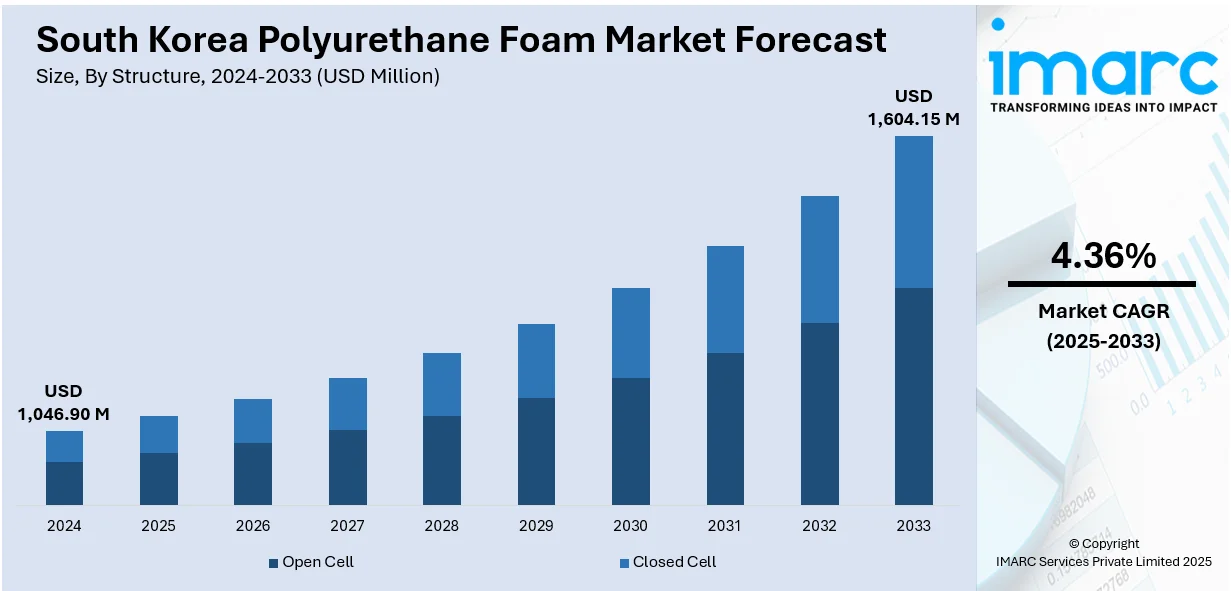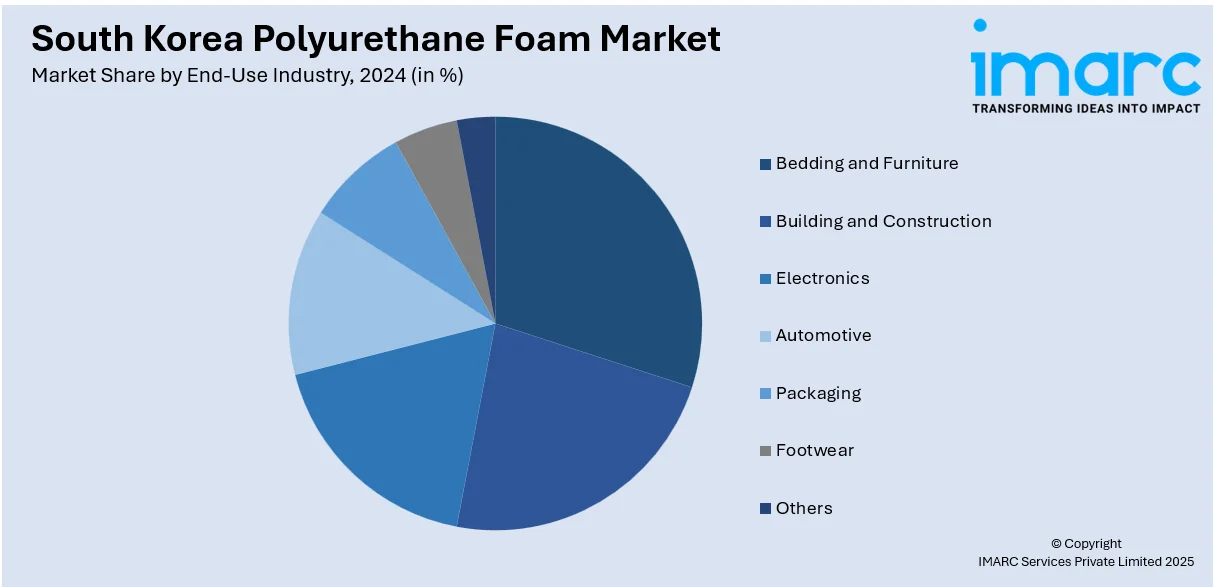
South Korea Polyurethane Foam Market Size, Share, Trends and Forecast by Structure, Product Type, Density, End-Use Industry, and Region, 2025-2033
South Korea Polyurethane Foam Market Overview:
The South Korea polyurethane foam market size reached USD 1,046.90 Million in 2024. Looking forward, IMARC Group expects the market to reach USD 1,604.15 Million by 2033, exhibiting a growth rate (CAGR) of 4.36% during 2025-2033. Increasing need in the automotive, construction, and furniture industries is one of the drivers behind South Korea polyurethane foam market share. Foam manufacture innovation, environmental policies encouraging green alternatives, and urbanization drive market expansion, together with growing consumer demand for high-performance and energy-efficient products.
|
Report Attribute
|
Key Statistics
|
|---|---|
|
Base Year
|
2024
|
|
Forecast Years
|
2025-2033
|
|
Historical Years
|
2019-2024
|
| Market Size in 2024 | USD 1,046.90 Million |
| Market Forecast in 2033 | USD 1,604.15 Million |
| Market Growth Rate 2025-2033 | 4.36% |
South Korea Polyurethane Foam Market Trends:
Shift toward Environmentally Friendly Alternatives
Over the past decade, South Korea's polyurethane foam industry has come a long way to embracing greener alternatives. With environmental regulations getting stricter and customers demanding greener products, manufacturers are now looking more into bio-based polyurethane foams. These polyurethane foams, which are derived from renewable materials like plant oils or natural fibers, possess a lower carbon footprint compared to the common petroleum-based counterparts. The movement is being driven by government incentive and worldwide attempts to keep plastic waste to an absolute minimum. Industry is spending money on R&D to create more effective, biodegradable products that can address insulation and comfort performance requirements. This green perspective aligns with the overall sustainability efforts of South Korea, which aim to be less wasteful and encourage clean technology. Consequently, the market will see growth in the production and application of bio-based polyurethane foams, with significant focus on uses such as furniture, automotive interior applications, and building insulation. The trend is in line with South Korea's growing focus on sustainable industrial practices and environmental stewardship. These factors are intensifying the South Korea polyurethane foam market growth.

To get more information on this market, Request Sample
Expansion of Polyurethane Foam in the Automotive Industry
South Korea's automobile sector has been a key driver of demand for polyurethane foam because of its lightweight and insulating features. As the automobile industry shifts to electric vehicles (EVs) and energy-efficient designs, the usage of polyurethane foam for seats, dashboards, and insulation materials is increasing. Polyurethane's ability to reduce vehicle weight while providing good thermal and acoustic insulation makes it an important material for enhancing energy efficiency in EVs. Furthermore, the rising customer need for increased comfort and noise reduction is encouraging manufacturers to include more foam-based materials in car interiors. As South Korea’s automotive industry continues to innovate with smart technology and environmentally friendly designs, the demand for specialized polyurethane foam will likely keep rising. With the advent of stricter fuel efficiency standards and a shift toward sustainable transportation, the market for automotive polyurethane foam in South Korea is expected to grow, presenting new opportunities for foam producers.
South Korea Polyurethane Foam Market Segmentation:
IMARC Group provides an analysis of the key trends in each segment of the market, along with forecasts at the country and regional levels for 2025-2033. Our report has categorized the market based on structure, product type, density, and end-use industry.
Structure Insights:
- Open Cell
- Closed Cell
The report has provided a detailed breakup and analysis of the market based on the structure. This includes open cell and closed cell.
Product Type Insights:
- Flexible Foam
- Rigid Foam
- Spray Foam
The report has provided a detailed breakup and analysis of the market based on the product type. This includes flexible foam, rigid foam, and spray foam.
Density Insights:
- Low Density
- Medium Density
- High Density
The report has provided a detailed breakup and analysis of the market based on the density. This includes low density, medium density, and high density.
End-Use Industry Insights:

- Bedding and Furniture
- Building and Construction
- Electronics
- Automotive
- Packaging
- Footwear
- Others
A detailed breakup and analysis of the market based on the end-use industry have also been provided in the report. This includes bedding and furniture, building and construction, electronics, automotive, packaging, footwear, and others.
Regional Insights:
- Seoul Capital Area
- Yeongnam (Southeastern Region)
- Honam (Southwestern Region)
- Hoseo (Central Region)
- Others
The report has also provided a comprehensive analysis of all the major regional markets, which include Seoul Capital Area, Yeongnam (Southeastern Region), Honam (Southwestern Region), Hoseo (Central Region), and others.
Competitive Landscape:
The market research report has also provided a comprehensive analysis of the competitive landscape. Competitive analysis such as market structure, key player positioning, top winning strategies, competitive dashboard, and company evaluation quadrant has been covered in the report. Also, detailed profiles of all major companies have been provided.
South Korea Polyurethane Foam Market Report Coverage:
| Report Features | Details |
|---|---|
| Base Year of the Analysis | 2024 |
| Historical Period | 2019-2024 |
| Forecast Period | 2025-2033 |
| Units | Million USD |
| Scope of the Report |
Exploration of Historical Trends and Market Outlook, Industry Catalysts and Challenges, Segment-Wise Historical and Future Market Assessment:
|
| Structures Covered | Open Cell, Closed Cell |
| Product Types Covered | Flexible Foam, Rigid Foam, Spray Foam |
| Densities Covered | Low Density, Medium Density, High Density |
| End-Use Industries Covered | Bedding and Furniture, Building and Construction, Electronics, Automotive, Packaging, Footwear, Others |
| Regions Covered | Seoul Capital Area, Yeongnam (Southeastern Region), Honam (Southwestern Region), Hoseo (Central Region), Others |
| Customization Scope | 10% Free Customization |
| Post-Sale Analyst Support | 10-12 Weeks |
| Delivery Format | PDF and Excel through Email (We can also provide the editable version of the report in PPT/Word format on special request) |
Key Questions Answered in This Report:
- How has the South Korea polyurethane foam market performed so far and how will it perform in the coming years?
- What is the breakup of the South Korea polyurethane foam market on the basis of structure?
- What is the breakup of the South Korea polyurethane foam market on the basis of product type?
- What is the breakup of the South Korea polyurethane foam market on the basis of density?
- What is the breakup of the South Korea polyurethane foam market on the basis of end-use industry?
- What is the breakup of the South Korea polyurethane foam market on the basis of region?
- What are the various stages in the value chain of the South Korea polyurethane foam market?
- What are the key driving factors and challenges in the South Korea polyurethane foam market?
- What is the structure of the South Korea polyurethane foam market and who are the key players?
- What is the degree of competition in the South Korea polyurethane foam market?
Key Benefits for Stakeholders:
- IMARC’s industry report offers a comprehensive quantitative analysis of various market segments, historical and current market trends, market forecasts, and dynamics of the South Korea polyurethane foam market from 2019-2033.
- The research report provides the latest information on the market drivers, challenges, and opportunities in the South Korea polyurethane foam market.
- Porter's five forces analysis assist stakeholders in assessing the impact of new entrants, competitive rivalry, supplier power, buyer power, and the threat of substitution. It helps stakeholders to analyze the level of competition within the South Korea polyurethane foam industry and its attractiveness.
- Competitive landscape allows stakeholders to understand their competitive environment and provides an insight into the current positions of key players in the market.
Need more help?
- Speak to our experienced analysts for insights on the current market scenarios.
- Include additional segments and countries to customize the report as per your requirement.
- Gain an unparalleled competitive advantage in your domain by understanding how to utilize the report and positively impacting your operations and revenue.
- For further assistance, please connect with our analysts.
 Request Customization
Request Customization
 Speak to an Analyst
Speak to an Analyst
 Request Brochure
Request Brochure
 Inquire Before Buying
Inquire Before Buying




.webp)




.webp)












